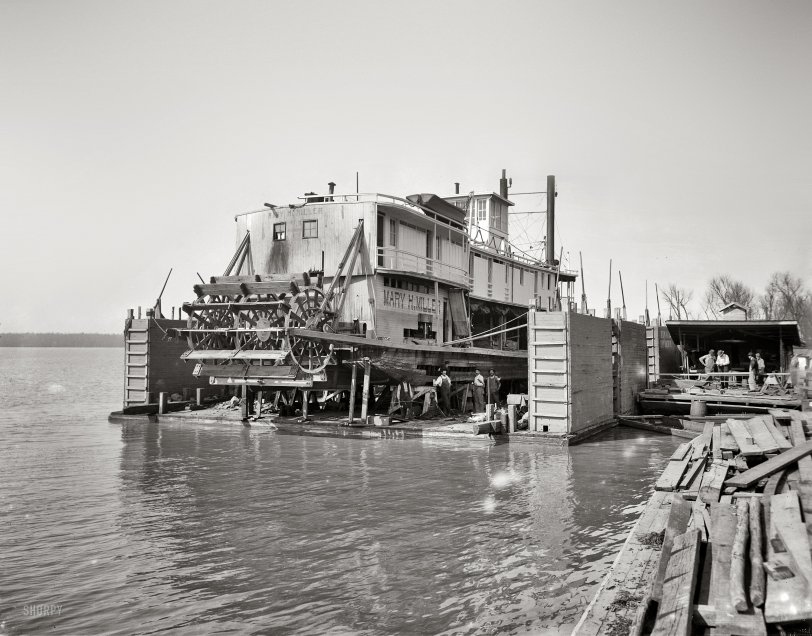


Framed or unframed, desk size to sofa size, printed by us in Arizona and Alabama since 2007. Explore now.
Shorpy is funded by you. Patreon contributors get an ad-free experience.
Learn more.

- Freeze Frame
- Texas Flyer wanted
- Just a Year Too Soon
- WWII -- Replacing men with women at the railroad crossing.
- Yes, Icing
- You kids drive me nuts!
- NOT An Easy Job
- I wonder
- Just add window boxes
- Icing Platform?
- Indiana Harbor Belt abides
- Freezing haze
- Corrections (for those who care)
- C&NW at Nelson
- Fallen Flags
- A dangerous job made worse
- Water Stop
- Passenger trains have right of way over freights?
- Coal
- Never ceases to amaze me.
- Still chuggin' (in model form)
- Great shot
- Westerly Breeze
- For the men, a trapeze
- Tickled
- Sense of loneliness ...
- 2 cents
- Charm City
- What an Outrage
- Brighton Park
Print Emporium
Mary H. Miller: 1905

Circa 1905. "A Mississippi River floating dry dock, Vicksburg." The sternwheeler Mary H. Miller. Detroit Publishing Company glass negative. View full size.
Floating Dry Dock
The caption says "floating dry dock." There is no winch attached to the pilings; the large boxes are tanks that are filled with water to lower the dock and emptied to raise it. Pumping was all done by hand (see the hand pumps on top). You can see a pump inlet/outlet at the base of the tank.
Charlie Noble
The two ports do indeed serve the galley on this fine vessel. You can tell by the "Charlie Noble" (galley smokestack to you lubbers) poking through the overhead. Charlie was a 19th-century British captain who insisted that the copper stack on his ship be brightly polished. He would be appalled by the sooty condition seen here, and the cook's helper would be in irons.
Dry Dock
It looks like the boat is brought onto the platform while it is submerged, and then the pump or ratchet handles are worked manually to raise the platform and boat together. I guess they either have to insert those big saw-horses just before the platform makes contact with the hull, or are the saw-horses permanently attached to the platform? There is a sign on the right front piling encasement -- "Finnie Dry Dock Co." Anyone have an idea how the platform is lifted on the pilings? Are there gears or cogs? Is it a pulley/winch system? Come on Shorpy engineers.
I've seen modern versions of these lift systems with huge hydraulic lifts at the port in Long Beach.
Snagged
The 1912 annual report of the U.S. Army Corps of Engineers records that "The wreck of the steamer 'Mary H. Miller' at lower end of Whites Bar, near Yazoo City [on the Yazoo River in Mississippi], was removed by a snag boat November 18-20, 1911. The cost of this work, $64.87, was reimbursed the United States by the owner of the wreck, under section 20 of the river and harbor act approved March 3, 1899."
The hull repairs seen in this postcard photo could have been the result of an earlier snagging accident, or possibly the normal periodic maintenance needed to replace rotting hull planks.
Galley Hell!
That's where the chamber pots were emptied.
Wash Me
After a big night on the town, Mary would go back to her room, get the bed spins, and hurl out her window.
I wonder what...
they dump out of the window right above the paddle wheel? Maybe it was the galley.
I wonder what...
they dump out of the window right above the paddle wheel? Maybe it was the galley.
Working boat!
Its nice to see a typical working boat instead of a showboat. Although perhaps the cook could have been a little more careful throwing out the slop.
























On Shorpy:
Today’s Top 5